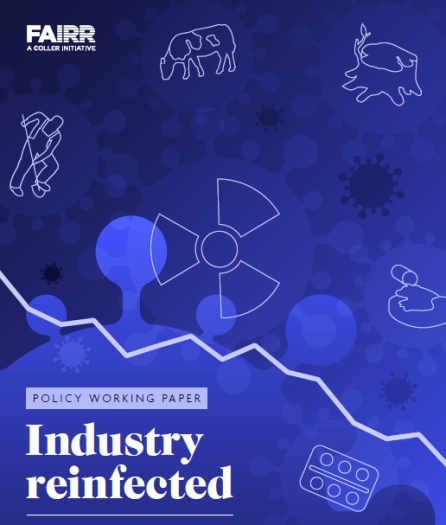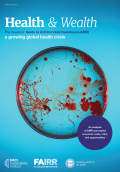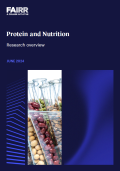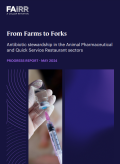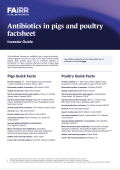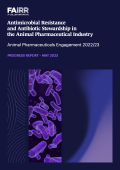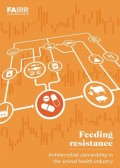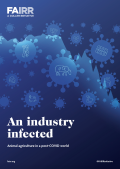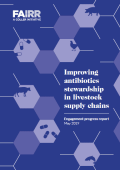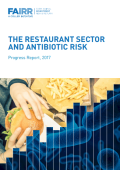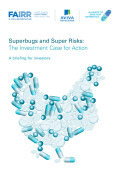Executive Summary
This working paper provides an update to our earlier report, ‘An Industry Infected’, looking at the performance of 60 of the world's largest protein producers against a set of indicators related to emerging disease risk. The results show that little has been done since 2020, with 63% of the 60 companies still ranking as “High Risk” (or worst performers). There is, however, some improvement since our previous report, when 73% of companies were ranked as “High Risk”. The paper also aims to shed light on policy developments that aim to prevent future zoonotic diseases.
Recent studies suggest that three out of every four new diseases are zoonotic, meaning they are transmissible from animals to humans. The role that the animal production industry plays, moreover, is critical to preventing new zoonoses. Although the origin of COVID-19 is currently unknown, pandemics like swine flu and avian flu have been transmitted directly from livestock to humans. Intensive animal production systems involve crowded conditions, lowered genetic diversity, live transport, and indoor confinement, all of which create an environment for new strains of diseases to emerge and spread. Furthermore, animal protein companies are often highly exposed to deforestation, which is linked to the emergence of new zoonotic diseases. Deforestation and biodiversity loss are among the worst-performing indicators in the assessment, with 76% of companies being ranked as “High Risk”. In addition, 98% of companies are ranked as “High Risk” when it comes to waste and pollution.
Not only is the animal production industry at risk of triggering the emergence of new diseases, but it also plays a role in their spread. Working conditions at meat processing plants, including proximity to other workers, and insufficient adequate protective gear, have contributed to meat processing plants being epicentres of COVID-19 outbreaks. The outbreaks have led to staff shortages and reduced processing capacity. This has impacted the entire protein industry, with farmers resorting to culling livestock to save on rising feed costs, creating material financial risks as a result. The pattern of disruption has been repeated globally, showing the industry’s fragility and vulnerability to external shocks and coming at a high cost to the economy, investors, and human health.
The Emerging Disease Risk Ranking combines the risk factors in the Coller FAIRR Protein Producer Index most relevant to this topic. These include deforestation and biodiversity loss, antibiotics, waste and pollution, working conditions, food safety and animal welfare, as well as sustainable proteins. The huge costs incurred by COVID-19 also demonstrate the old adage that “prevention is cheaper than cure”. In this light, the paper summarises some of the key policy trends related to the prevention of emerging disease risks, which will be of interest to investors and global policymakers alike.
Introduction
Since the initial FAIRR report came out, there have been multiple academic articles confirming our view that various environmental, social and governance (ESG) factors in the Index are linked to emerging disease risk, and some of this research is summarised in this section. The United Nations Environment Programme (UNEP) recognises seven human-mediated factors that are most likely driving the emergence of zoonotic disease, with five of these being directly or indirectly linked to intensive livestock production. There have been calls for an intergovernmental panel on pandemic risk to better understand how diseases become pandemics, as well as policies to prevent the spillover of pathogens from animals to people.
Intensive livestock systems can amplify the transmission of disease as billions of animals are reared annually with low genetic diversity, high stress, poor health conditions, and close proximity to each other. Poor sanitary conditions of intensive farming environments have also been responsible for the spillover of diseases, such as Nipah. As an example, avian flu continues to spread across poultry farms globally, and due to its “easy cross to humans”, scientists have been calling for more research to prepare for a potential epidemic or pandemic. In February 2021, Russia alerted the WHO to the first case of an avian flu mutation (H5N8) in a human. In the UK, the first case of a human being infected with avian flu was announced in January 2022, with the WHO notified. Outbreaks of avian flu can also occur when infected wild birds (or their faeces) come into direct contact with poultry.
Natural habitat destruction and loss also increase the chance of contact between humans and wildlife, as the clearing of land leads to more human-animal and environmental interactions enabling the animal-human transfer of new emerging diseases. Deforestation also increases the stress of wildlife, driving pathogen shed and excretion, which in turn facilitates pathogen spread and potential disease spillover. Agricultural expansion drives nearly 90% of global deforestation, which is closely linked to the demand for commodities like beef, palm oil and soy. Just seven agricultural commodities were responsible for 26% of global deforestation from 2001 to 2015, with cattle production alone driving 16% of total tree cover loss. The Intergovernmental Science-Policy Platform on Biodiversity and Ecosystem Services (IPBES) also emphasised that mammals are the most important reservoir of pathogens with pandemic potential and that the growing risk of zoonotic diseases is driven by human activities like agricultural expansion through deforestation.
Labour risks have been highlighted as a risk factor during COVID-19, with meat processing plants frequently at the centre of COVID-19 outbreaks – often attributed to working conditions such as high humidity and lack of social distancing, with livestock workers and their communities facing 51%-75% higher COVID-19 contagion rates and 37%-50% more deaths.38 The lack of disclosure around sick pay policy, or a lack of policy altogether, also compels workers to attend work while unwell, spreading contagion (see box below). Bottlenecks caused by labour shortages in the supply chain have also impacted prices for end consumers.
Future research holds the potential for satellite data to be used to identify and track which companies are responsible for deforestation in at-risk biodiversity hotspot areas such as the Amazon, the Cerrado, and the Congo Basin. Certain areas of the world, like forested tropical regions, are also at higher risk when it comes to emerging disease risk – for example, areas with high biodiversity or high population density (see below). These areas often experience high levels of land-use change and have significant wildlife biodiversity (mammal species richness). It is clear that more research needs to be done on other drivers of emerging disease risk, for example, biosecurity risk, wildlife exploitation, and geographically-specific risks such as deforestation.
However, there are challenges to integrating location-specific data into a piece of research like the Emerging Disease Risk Ranking, since protein producers have global supply chains. Even with full disclosure on operations, traceability is difficult due to the complexity of supply chains – for example, cattle are often moved around before reaching protein producer companies. Moreover, supply chains are fragmented, with most of these companies only involved at the processing stage. In future, with better disclosure against current indicators on deforestation and traceability, it may be possible to add an additional indicator on companies’ exposure to “High Risk” hotspots within global supply chains. To comprehensively understand and mitigate the risk of new emerging diseases from the agriculture sector, full disclosure on where and how companies are operating is essential.

